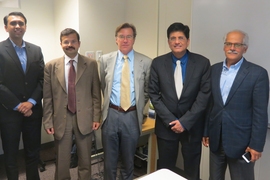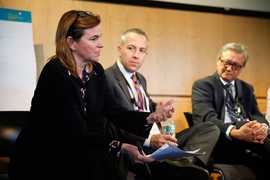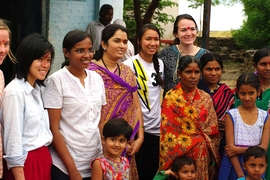On Sept. 29, influential thinkers from across the globe came together for the Tata Center for Technology and Design Annual Symposium at the MIT Media Lab. MIT faculty were joined by leaders from India’s business, nonprofit, and government sectors in a series of lively panel discussions on the challenges and opportunities of applying MIT research in India and the developing world.
In his keynote address, entrepreneur and philanthropist Gururaj “Desh” Deshpande encouraged MIT faculty and students to see research in the developing world as a unique prospect. “I don’t want you to underestimate the insights that come from working with resource-constrained communities,” he said. “When a professor assigns a problem, it’s homework. When a student goes into the field and finds a problem to solve, it’s an entrepreneurial experience.”
As if to prove his point, Katherine Taylor SM ’15, a former Tata Fellow and now CEO of Khethworks, told the assembled crowd about her experiences developing an optimized solar irrigation pump. It was a problem, she said, that her team stumbled upon almost by accident. Now they’ve taken a market-driven approach to solving it. “We’re a for-profit company because we believe that’s the best way to achieve scalability and reach the 30 million farmers who can use our pump.”
Assistant Professor Amos Winter of the Department of Mechanical Engineering added, “We can do social good while also making a profit. Those two are not mutually exclusive.” A profit incentive, he argued, could help technology have a wider reach. “We’re not just addressing developing market issues, we’re addressing global issues.”
Social entrepreneur Harish Hande, founder of the Solar Electric Light Company of India, said we should look at the poor “not as beneficiaries, but partners.” He emphasized the need for a holistic approach to any problem. “Unless we look at all parts of the puzzle together, we will not be able to create an appropriate solution from end-to-end.”
A persistent theme throughout the day was the importance of establishing relationships with local partners who can help assemble that puzzle: identifying problems that require solutions, providing connections to the community, and aiding in distribution.
This theme resonates with the core mission of the Tata Center: to train engineers and entrepreneurs who can work closely with local partners and community members to create appropriate, practical solutions for resource-constrained communities. Founded in 2012 at MIT, the Tata Center supports graduate students and faculty engaged with a broad spectrum of issues impacting the developing world.
“MIT is not arriving in India with answers,” said Professor John Ochsendorf of the Department of Architecture. “We have to listen with humility to our Indian partners.” The idea for Ochsendorf’s Tata Center project, Eco-BLAC Bricks, originated with local government in the industrial city of Muzaffarnagar, India. “Answering questions is easy, finding the good questions to ask is the real challenge in research. I’ve been on the MIT faculty for 14 years, and working with the Tata Center is the first time I’ve seen direct impact from our projects.”
The Deshpande Foundation’s Raj Melville echoed this sentiment: “Working on the ground with organizations that understand what is critical helps refine your ideas.”
In that spirit, Sandeep Virmani of the India-based Hunnarshala Foundation laid out a number of research questions he hoped MIT faculty could engage with. They ranged from groundwater recharging, to decentralized sewage services for informal settlements, to animal husbandry. Virmani’s organization specializes in building technology, and is preparing to erect 30,000 low-income homes in the city of Bhuj using designs created in collaboration with the Tata Center. Meanwhile, the state of Gujarat has incorporated Tata Fellow Chris Porst’s research on confined masonry into the state building code.
The Tata Center Annual Symposium was just one example of increasing connection between MIT and India. A few days earlier, a contingent of Tata Center researchers, including Taylor, met with Indian Prime Minister Narendra Modi. On Sept. 24, India’s minister for coal, power, and renewable energy, Piyush Goyal, paid a visit to MIT. Goyal sought expertise from the MIT Energy Initiative and the Tata Center to help meet India’s ambitious energy targets, and both sides are working toward a bi-lateral collaboration.
A lunchtime expo gave symposium attendees a first-hand look at Tata Center projects, and the event concluded with the release of the Tata Center’s yearly call for proposals, which invites MIT principal investigators to apply to receive holistic support for their research.
R. Venkat of the Tata Trusts encapsulated the message of the day when he said, “There is a strong economic incentive to make products and solutions for India. But we should not be driven by an excess of greed; our mission is to make a difference.”












